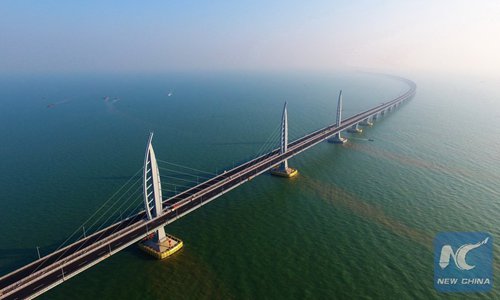HOME >> CHINA
Greater Bay Area to get 600-km-per-hr train
By Zhang Hui and Chu Daye Source:Global Times Published: 2019/11/15 21:38:40

Traversing over the busiest waters in S China, the world's longest sea bridge signals boom for Greater Bay Area
China's top economic planner is pushing for the approval of plans on infrastructure connectivity, ecological protection, industry development and inter-city railways in the Guangdong-Hong Kong-Macao Greater Bay Area. Media reports said a 600-kilometer-per-hour maglev train service is a highlight of the region's infrastructure blueprint.
Meng Wei, spokesperson of the National Development and Reform Commission (NDRC), said the government will implement significant policies beneficial to Hong Kong and Macao in the next stage. Infrastructure construction, including the construction of several high-speed railways in the area, is on schedule. She made these remarks at a media briefing on Friday.
The Nandu Daily newspaper reported on Friday that a maglev train is likely one of these transportation linkages.
The report cited a document issued by the Development and Reform Commission of Shenzhen on plans of maglev lines linking Guangzhou and Shenzhen.
China has rolled out a maglev prototype that can run at a speed of 600 kilometers per hour, potentially linking the two major cities in China within 20 minutes.
Li Hongchang, a professor at Beijing Jiaotong University, told the Global Times that the economic feasibility remains one of the core issues for planners as China has basically overcome the technological difficulties for mid and high-speed maglev trains, which are much faster than those in service in China today.
"The success of the high-speed railway and being part of a network, unlike the maglev running on a separate line, will pose a strong challenge to the economic feasibility of the proposed maglev train," Li said.
However, given China's ambition to keep its lead in railway technology and the vast market potential of the Greater Bay Area, the local government could launch such project even at an initial cost disadvantage. Japan is building a maglev line linking Tokyo and Nagoya.
The construction of the technology innovation center at the Greater Bay Area has made considerable progress.
For example, construction has begun on a Hong Kong University of Science and Technology collaboration project in Guangzhou, according to NDRC.
RELATED ARTICLES:
Posted in: SOCIETY